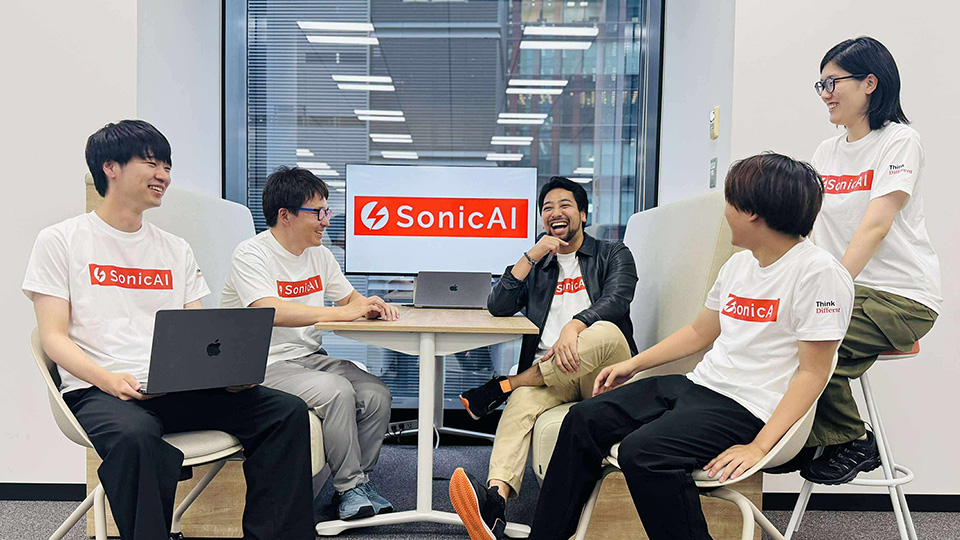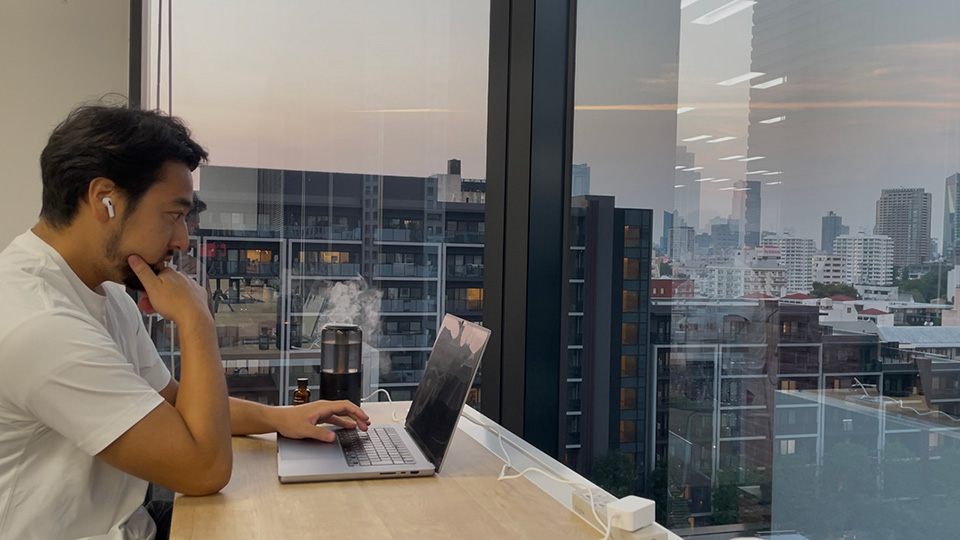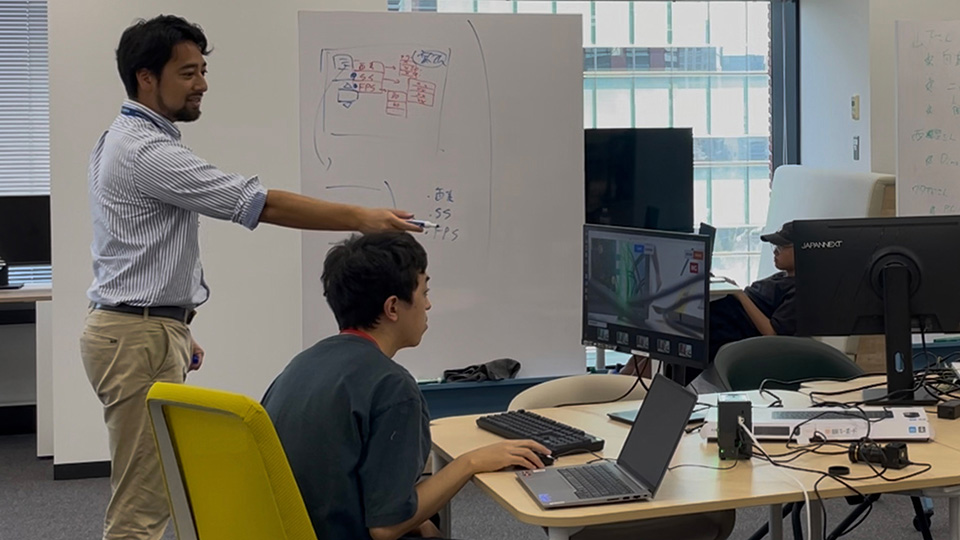- TOP
- About
- Affiliated League
- Information
- League Members
- Partners
- League Report
Search League Members
-
公式X
Japan's manufacturing industry, its largest industrial sector, faces a severe labor shortage on high-mix, low-volume production floors. Processes like visual quality inspection and material handling, in particular, have remained reliant on manual labor and difficult to automate.
SonicAI Inc. is taking on these non-automated, high-mix, low-volume lines—long considered tasks "only humans can do"—with an edge device that fuses proprietary 2D image processing AI software with hardware.
CEO Hiroyuki Tanaka, after graduating from Keio University's Faculty of Economics, worked in technical sales for image processing systems at Keyence, a major player in FA (Factory Automation). He later joined A.T. Kearney, a leading global US management consulting firm, and participated in multiple manufacturing industry projects.
With such a background, Mr. Tanaka chose not to focus on FA for large manufacturers, but on solving the structural problems of small and medium-sized manufacturing enterprises (SMEs). He achieved a breakthrough with "SonicAI," an integrated product combining an edge device (hardware) and deep learning software, to tackle the difficult challenge of automating inspection and handling—a feat previously elusive as it was thought to require big data.
We explore his reasons for tackling the "automation of production lines in SMEs," long considered a difficult problem to solve, and the future envisioned by his team of brilliant minds, united under the grand vision of "carrying work that only humans can do into the future."
 AI development members (as of August 2025)
AI development members (as of August 2025)First, please tell us about the origin of your company. What specific problems or awareness led you to start this business?
Tanaka: We are currently developing automation products for inspection and handling, specifically targeting high-mix, low-volume small and medium-sized manufacturers. The origin of this lies in my previous job experience. At Keyence, which I joined as a new graduate, I worked in technical sales, proposing a wide range of automation solutions to major manufacturers' factories.
On the other hand, smaller factories with no production line automation face labor shortages and quality control issues, yet the highly automated solutions designed for large companies are completely unsuitable for them. This problem has been left unaddressed for years, and I felt a strong sense of frustration about it.
Did the environment you grew up in—Ota Ward, part of the Keihin Industrial Zone known for manufacturing—also influence you?
Tanaka: Yes. Growing up in Ota Ward, surrounded by small factories, I experienced the challenges of SME manufacturing firsthand from a young age. Later, after moving to A.T. Kearney, I worked as a management consultant on cost reduction projects for large manufacturers. In that role, I was on the side negotiating cost reductions from a position of strength with the subcontracting small factories.
However, seeing how the burden was shifted onto these small subcontractors, it pained me to think, "In the end, we're just making someone else suffer."
So those experiences prompted you to aim for a "product that increases the profit margins of SMEs" involved in high-mix, low-volume production.
Tanaka: Exactly. I started this business with the desire to "create a product that allows SMEs to operate sustainably and increase their profits."
 CEO Tanaka always strongly emphasizes "Quick & Dirty" to the team)
CEO Tanaka always strongly emphasizes "Quick & Dirty" to the team)So, what specific problems does the AI edge device "SonicAI" you're developing actually solve?
Tanaka: We are targeting the "automation of inspection and handling processes in high-mix, low-volume manufacturing sites." We are specifically tackling the "non-automated domain," which includes "manual visual inspections," estimated to be done by about 1.4 million people nationwide, and "complex, high-mix handling tasks," said to involve a similar number of people. Financial data clearly shows that an overwhelming proportion of personnel costs in SMEs is spent in this area, so we started by thinking about how we could compress these costs.
Understanding the problem is one thing, but being able to solve it is another, isn't it?
Tanaka: Yes, so we first identified about 100 problems and formulated a solution hypothesis for each. Then, working with AI researchers and research scientists, we narrowed down the areas where the depth and breadth of the need aligned with technological feasibility to just three. Ultimately, the most promising path appeared to be an edge device—"hardware equipped with AI technology."
But why have these processes been so difficult to automate until now?
Tanaka: In high-mix, low-volume sites, many different types of products pass through the production line, making it difficult for conventional automation equipment designed for mass production to cope. Creating an AI inference model requires a labeling process where the AI learns what is "good" or "bad" for each product from a massive amount of data. However, for SMEs, just collecting that much data is difficult in the first place, posing a high barrier to adoption.
What is the difference between high-mix, low-volume lines and mass-production lines?
Tanaka: For example, in the "visual process inspection" before product shipment, workers must visually check each item for fine scratches. In a mass-production setting making large quantities of the same standardized product, it's easy to create patterns from big data and automate the inspection. However, in a high-mix, low-volume site, the products themselves are varied and not uniform, and each is produced in small batches.
Another example is the "handling" process on the line—picking up an object, placing it, and sending it to the next step. In mass production, where the same product comes down the conveyor every time, this is a simple task of picking from and placing at fixed coordinates. In contrast, on a high-mix, low-volume line where different items come through each time—soft items, hard items, items at different angles—it becomes very difficult to handle.
SMEs can't collect the big data needed for AI learning in the first place. How did you overcome this "data shortage" problem?
Tanaka: We focused on the specific question of "how to achieve automation with a small amount of data without sacrificing quality." We concentrated our R&D on lightweight AI models that can be implemented and operated with minimal learning, and it's actually going quite well. For example, we can propose solutions where a visual inspection process that used to require 10 people can be handled by just two after implementation. It's an incredibly smart AI system that performs the "role of eyes and brain" tens of times faster than a human.
However, if you customize too much for individual high-mix, low-volume factories, you lose versatility and can't capture a large market. Balancing this with general applicability seems crucial.
Tanaka: You're absolutely right. The biggest fear is focusing too much on the customer and failing to ensure versatility. That's why our edge device is designed so that the customer can easily tune the inspection criteria, processing speed, and hardware configuration themselves.
What does that mean specifically?
Tanaka: For example, in inspection and handling processes, "how fine a scratch do you want to detect?" or "at what processing speed do you want to inspect or handle the product?" will differ from site to site. Therefore, it's crucial to have a product that ensures versatility while also allowing for easy customization for each factory, each lot, or each quality standard.
Our business model isn't to create a manufacturing line or dedicated machine that contractually covers "100%" of every need. Instead, we develop a product that satisfies "80%," which is the greatest common denominator of customer needs, and the customer customizes the remaining part. This way, we aim to provide a high-value solution that deeply meets needs while also ensuring scalability (the flexibility to expand or adapt).
Is the hardware that runs the system manufactured by an OEM (Original Equipment Manufacturer)?
Tanaka: While the manufacturing of components like semiconductors is outsourced, the core parts—such as selecting the necessary hardware, assembly, and circuit design—are designed by us before we commission the manufacturing. Regarding the GPUs (graphics boards) frequently used in edge devices, we are currently collaborating with NVIDIA, the industry-leading US semiconductor manufacturer. We receive product loans from them and are advancing R&D on hardware configuration requirements and other aspects.
 A culture that values decision-making through discussion. (Photo shows CEO Tanaka in discussion with a front-end engineer)
A culture that values decision-making through discussion. (Photo shows CEO Tanaka in discussion with a front-end engineer)By the way, what has been the biggest breakthrough in advancing this business?
Tanaka: It was the "successful R&D of our core AI technology," which we achieved this past July. For the last six months, we've been repeating a cycle at an incredible speed: finding seeds for papers on technology that doesn't exist yet, citing them, implementing them, and experimenting.
The moment it was proven that we could achieve both "small data volume" and "high quality" without any trade-off—something previously thought impossible—the entire team rejoiced, thinking, "We can really win this!"
I am confident that there is likely no other team in Japan right now pursuing social implementation so intently focused on the specific point of "how to improve quality with small amounts of data."
And that led to the release of the beta version. What was the response from the market?
Tanaka: It was overwhelming. This September, we held a closed demonstration of the beta version of this AI edge device for about 20 chambers of commerce, limited to Aichi Prefecture, where Japan's auto industry, including Toyota and Denso, is concentrated. We were flooded with 50 to 100 implementation requests.
We also gave them an idea of the price, and everyone's first reaction was, "That's cheap." Before presenting the price, I was worried they would find it expensive. But the "cheap" reaction showed that they see high value in this product and reflects the market's deep-seated need and expectation that "what was impossible before can now be done at this price point." It gave us great confidence.
In response to this, we will open an office in Nagoya in addition to Tokyo starting in November and begin full-scale business development. It's still pre-launch, so it's closed, but the device is also available at "STATION Ai," a new startup support hub in Nagoya. We have set up a framework to invite customers to the office, coordinating with about 15 chambers of commerce, city offices, and local financial institutions in cities like Kariya, Okazaki, Komaki, and Toyohashi.
What are your expectations regarding support from the ICT Startup League?
Tanaka: The opportunity to "gain implementation opportunities by borrowing on future credit" is extremely significant. The other day, we showed a demo video of the beta version to the person in charge, and we received a great response from the secretariat, saying it was "amazing." As we head toward the official launch at the end of the year, we have high expectations that collaborating at this timing will accelerate our business's credibility and expand its adoption.
Finally, what kind of people do you want to build the company's future with?
Tanaka: We chose "orange" as the color to symbolize our company, and this was a conscious nod to the corporate colors of major FA companies. On the factory floor, manufacturers are identified by color, like Keyence's "red" or Omron's "blue." We strategically chose "orange" because it's currently available and also stands out on site.
Our goal is that when a problem arises on a high-mix, low-volume site, people immediately associate "orange with SonicAI." We want to grow at "sonic speed" ourselves, so that this entire domain becomes filled with orange.
To grow at this "sonic speed," we don't need "people who work hard for the team" as much as we need "people who have been absorbed in their own research themes and achieved overwhelming results as individuals." Looking back on my own life, I feel I've "broken through with individual strength," and I place great importance on an attitude of thoroughly pursuing one's individual expertise.
We are waiting for "sharp individuals" who share our grand future vision of "unleashing the potential of Japan's manufacturing industry."
Editor's Postscript What was most impressive about the interview with Mr. Tanaka was his "passion" and "resolve." His powerful, experience-driven desire "not to settle for solutions that just shift the burden onto someone else" regarding the structural issues facing Japanese SME manufacturing—starting with the Keihin Industrial Zone where he was born and raised—came through clearly. Mr. Tanaka's vision is clear. In three years, become the overwhelming leader in automation solutions for the non-automated, high-mix, low-volume domain. In five years, expand to the large markets of North America and Southeast Asia. In the future, aim to completely solve the labor shortage problem in manufacturing. His words about "aiming to be a global startup from Japan" in this focused domain do not feel like a mere dream. Ultimately, Mr. Tanaka aims to realize a world where SME manufacturing sites are freed from skill-dependent manual tasks, allowing people to engage in more creative manufacturing and work that boosts Japan's potential. I want to see that future as soon as possible.
■ICT Startup League This support program was launched in FY2023, originating from the Ministry of Internal Affairs and Communications' "Program for supporting R&D in the seed phase targeting startup creation." The ICT Startup League supports startups through four pillars: 1. R&D Funding / Hands-on Support Up to 20 million yen in R&D expenses is provided in the form of subsidies. Additionally, through hands-on support, the selection committee members involved in choosing the league members continue to mentor and promote their growth even after selection. For companies that committee members evaluated as "absolutely want to select," a "fan-like" support system is in place, where the committee members themselves provide ongoing support, such as advice on business plans and opportunities for growth. 2. Discovery & Development We provide opportunities for learning and networking to promote the business growth of league members. We also work to discover aspiring entrepreneurs, aiming to broaden the base. 3. Competition & Co-creation It serves as a place for positive competition, much like a sports league, with a system where startups learn together, engage in friendly competition, and win the funding (up to 20 million yen) they truly need. We also provide a venue for co-creation, where league members can collaborate and expand their businesses through various opportunities, such as sessions by the selection committee members. 4. Promotion We collaborate with media to publicize the initiatives of league members! By raising awareness of their businesses, we aim to expand opportunities for new matching and chances.
■Related Websites SonicAI Inc. / SonicAI Inc. (LEAGUE MEMBER) / ICT Startup League